Undertow (1949)
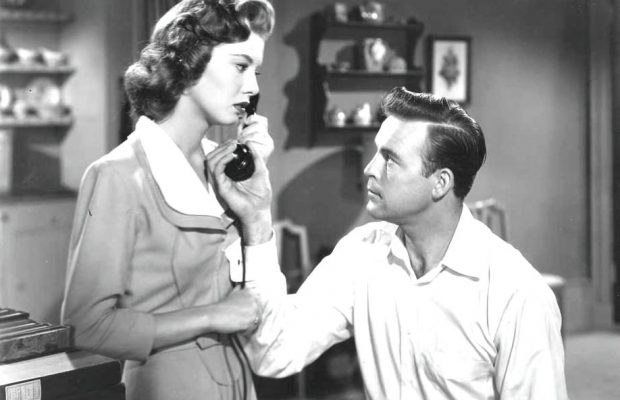
Toronto Film Society presented Undertow (1949) on Monday, July 8, 2019 in a double bill with Ride the Pink Horse as part of the Season 72 Summer Series, Programme 1.
Production Company: Universal International Pictures. Director: William Castle. Producer: Ralph Dietrich. Screenplay: Arthur T. Horman, Lee Loeb, based on a story by Arthur T. Horman. Cinematography: Irving Glassberg. Editor: Ralph Dawson. Art Direction: Bernard Herzbrun, Nathan Juran. Set Decoration: A. Roland Fields, Russell A. Gausman. Gowns: Orry-Kelly. Release Date: December 1, 1949.
Cast: Scott Brady (Tony Reagan), John Russell (Danny Morgan), Dorothy Hart (Sally Lee), Peggy Dow (Ann McKnight), Bruce Bennett (Det. Charles Reckling), Gregg Martell (Frost), Robert Anderson (Stoner), Dan Ferniel (Gene), Rock Hudson (Detective), Charles Sherlock (Cooper), Anne P. Kramer (Telegraph Clerk).
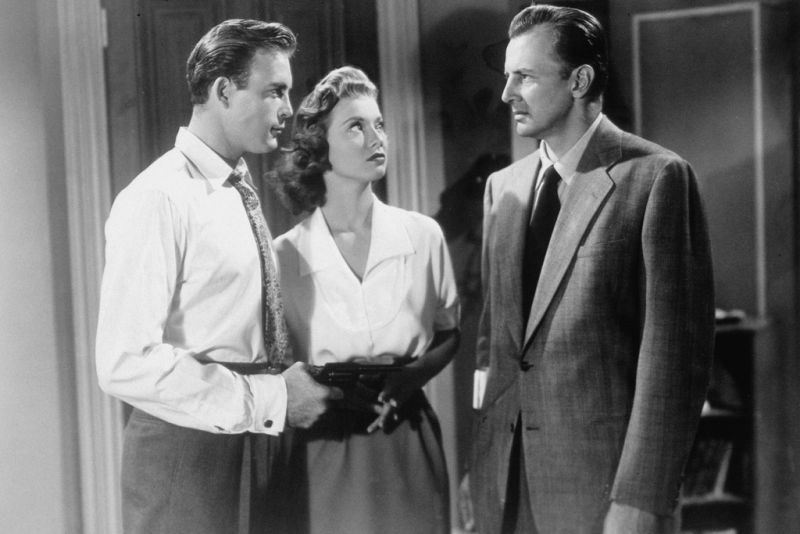
Peggy Dow, who’s real name was Peggy Varnadow, made her big screen debut at the age of 21 in tonight’s film Undertow which was originally titled The Big Frame.
Bruce Bennett, who plays Detective Charles Reckling, started out his career by playing the hero in serials under his birth name Herman Brix. If any of you were at this year’s Cinevent, you would have seen him in Hawk of the Wilderness playing a shirtless, Tarzan-like hero living on a lost island somewhere north of the Arctic Circle. Yes, apparently, it was tropic there. Around 1940, Brix, wanting to break out of these types of roles and into making Hollywood films, changed his name to Bruce Bennett, left Republic Studios and became a member of Columbia Pictures’ stock company.
Undertow is noteworthy for a brief scene that is not particularly central to the plot. About an hour into the narrative when Detective Reckling, played by Bruce Bennett, is leaning over a desk in his office, feeling flustered because he doesn’t have any leads in the case, a second detective enters the room. Although an unimportant character, it’s Rock Hudson in his second film appearance. So keep a look out!
Sourced from Showmanship: The Cinema of William Castle by Joe Jordan (2014), Cinevent Notes 2019
Introduction by Caren Feldman
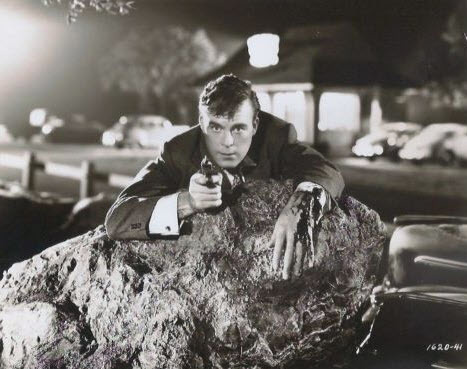
Director William Castle is perhaps best known for his gimmicky suspense and horror films of the late-’50s and early-’60s. However, he was a versatile director who during his career made many film noir and crime dramas, as well as westerns and adventure films. Castle was born William Schloss Jr. in New York City in 1914. He was orphaned at aged 11 upon the death of his parents, and went to live with an older sister. When he was 13, he went to see the play Dracula starring Bela Lugosi. He was so impressed that he saw the play many more times and eventually met Lugosi. The two of them became friends and Lugosi recommended Castle for the job of assistant stage manager for the road company tour of the play. Castle dropped out of school at age 15 to begin his stage and film career and changed his surname to Castle, as Schloss was German for castle. He spent his teenage years working in the theatre doing everything from set building to acting.
His ambition and drive led him to approach Orson Welles in 1941 to ask for the loan of the Stony Creek Theatre in Connecticut, since Welles was leaving to film Citizen Kane. Castle’s creativity and audacity came into play when he hired a German actress to star in a non-existent play. Theatre rules at the time said German-born actors could only appear in plays that had originally been performed in Germany. So Castle spent a weekend writing Das ist nicht fur Kinder (Not for Children). The actress he had hired, Ellen Schwanneke, had been invited by the Nazi Party to attend a performance in Berlin. Castle then created a false telegram that he released to the press in which Schwanneke and Castle refused the request. Castle portrayed his star as “the girl who said no to Hitler”. He secretly vandalized the theatre by painting swastikas on it. This gimmick worked and the play he had written in 48 hours became a success.
At the tender age of 23, he was hired by Harry Cohn at Columbia Pictures. People close to Cohn and Castle said that William Castle was one of the few people that Harry Cohn actually liked. Castle spent two years at Columbia learning the film business. He directed two WWII propaganda films and in 1943, Cohn gave him his first directorial job with the western Klondike Kate followed by the Boston Blackie film Chance of a Lifetime. He went on to direct four of The Whistler series films and was an associate producer on Orson Welles’ Lady from Shanghai. He could make films quickly, efficiently, and, more often than not, under budget. Castle directed films for Columbia from 1943 to 1956. He then knew it was time to become independent and make the films that he wanted to make. He had seen the French film Les Diaboliques (1955), and was inspired to mortgage his home to finance his first independent film, Macabre (1958). A screen title at the end of the French film asked viewers not to reveal the ending. Castle not only borrowed that for the end of Macabre, he also gave every customer an insurance certificate from Lloyds of London in case they died of fright during the film, and stationed nurses in the lobby. Macabre was a hit and Castle went on to make more of his popular ‘gimmick’ films.
Castle followed Macabre with The House on Haunted Hill (1959) starring Vincent Price. In select theatres, Castle had a skeleton with glowing red eyes rigged to fly out over the audience to coincide with a climactic scene. In The Tingler (1959), also starring Vincent Price, Castle had some seats in the theatre rigged with electric motors that would vibrate at a critical moment when the Price character would tell the audience to scream for their lives. For 13 Ghosts (1960), filmed in “Illusion-O”, he gave out blue and red cellophane glasses that allowed the audience to see or hide ghosts when they appeared on screen. In Homicidal (1961) he gave the audience a “fright break” as the heroine approached the house where a sadistic killer was hiding. Patrons were offered a full refund if they chose to leave at that point. Only 1% of audiences chose the refund. Other gimmicks included a magic coin for Zotz (1962) and a worldwide talent search for pretty young women for 13 Frightened Girls (1963). The star of Straight Jacket (1964), Joan Crawford, did promotional appearances in a number of cities, and Castle gave out cardboard axes to audiences. Joan Crawford also starred in his next film, I Saw What You Did (1965). The premise of the story has two teenage girls calling random phone numbers and saying, “I saw what you did.” This caused a rash of prank calls and complaints to Bell Telephone.
Castle’s influence on Hollywood and filmmaking cannot be underestimated. Filmmakers Robert Zemeckis and John Waters credit William Castle as a major influence in their work. Waters appeared as William Castle in the 2017 FX television series Feud, the story of the antagonistic relationship between Bette Davis and Joan Crawford. Alfred Hitchcock decided to make Psycho (1960) after seeing the success of Castle’s movies and those of director/producer Roger Corman. Director Joe Dante based his character Lawrence Wolsey on Castle in his 1993 film Matinee. John Goodman played Wolsey, the flamboyant director of the film-inside-the-film Mant: Half Man Half Ant, filmed in Atomo-Vision and Rumble-Rama. A documentary on his life won the Audience Award for Best Documentary at the American Film Institute Fest in 2007, and his daughter Terry Ann Castle remade two of his films as co-producer of The House on Haunted Hill (1999) and Thirteen Ghosts (2001).
A major disappointment in his life was not being able to direct Rosemary’s Baby (1968). He mortgaged his home to purchase the film rights to Ira Levin’s novel with the intention of directing an A-movie. He made a deal with Paramount to make the film, but the studio insisted on having Roman Polanski direct it; Castle had to settle for the producer credit, a cameo role. He became ill with kidney disease shortly after the release of the film and was unable to benefit from its momentum. Once he’d recovered, he made only three more low-budget films and had a significant role as a director in Day of the Locust (1975) before poor health made him retire from making movies. William Castle died of a heart attack on May 31, 1977 in Los Angeles.
Notes by Bruce Whittaker


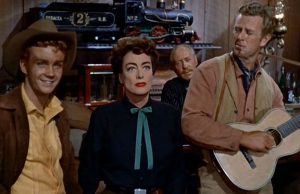
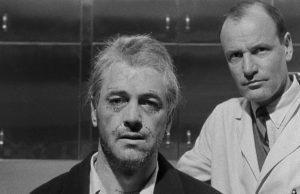






Leave a Reply